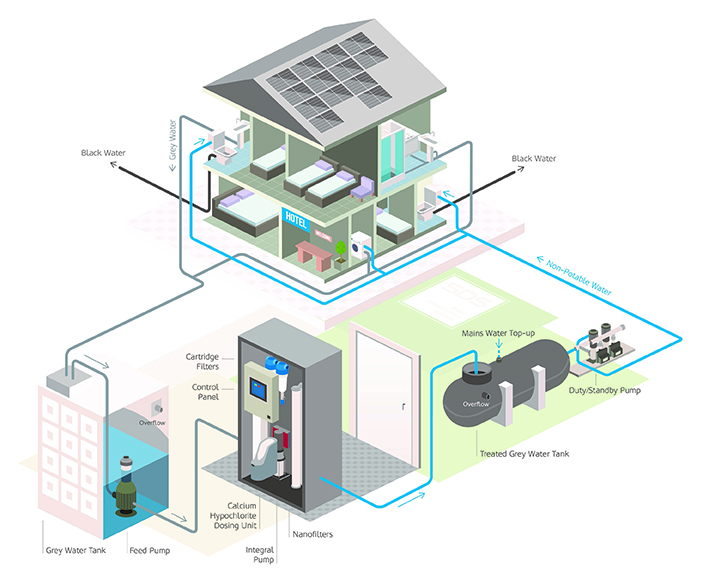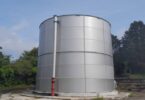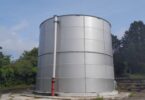Exclusive interview: H2O Global News writer Natasha Posnett, spoke to SDS about why grey water recycling is important
Why is grey water recycling important?
England is still on a trajectory to start running out of treated mains water within 20 years. By 2050, the deficit is predicted to reach 3,500 million litres per day. And yet, we flush a third of our high-quality mains water down our toilets at home every day. So, we need to find and implement a technology that helps us reuse wastewater.
Grey water is wastewater from any household source other than toilets. It can be filtered, treated and then reused for non-drinking purposes such as toilet flushing, laundry or garden irrigation. With climate change at the forefront of people’s attention and population numbers on the rise, this technology is an important way forward when looking at the future of water.
We are staring climate change in the face. The extremes of drought and heavy rainfall are already commonplace weather patterns. It’s an emergency that demands an imperative response: reduce personal water demand from the current 140 litres per day average. If we reduced per capita consumption to 100 litres per day and leakage by 50%, and did nothing else, there would be enough water for an additional 20 million people.
What grey water system does SDS offer?
SDS offers grey water on-demand recycling systems supplied as package treatment plants. The ‘WaterBank®’ large scale system uses a sequence of cutting-edge disc filtration and ultrafiltration processes unique to the UK.
Have there been technological advances in the industry over recent years, and what are their benefits?
Grey water technologies have moved on significantly in recent years to help meet global challenges. A better understanding and evidence of what they can achieve is essential to drive informed policy decision-making, as well as adoption by key players, such as architects, engineers, developers and planners.
Advances in grey water technology using the new ‘on-demand’ process provide a more responsive and cost-efficient process that makes the ‘Return on Investment’ more favourable. The new technology also offers early adopters of grey water systems the opportunity to replace their high-maintenance MBR systems with more efficient and cost-effective systems.
In the past, Membrane Bioreactor (MBR) systems were the technology of choice for grey water reuse. However, the smaller footprint of on-demand systems, together with their ability to provide quality recycled water whenever needed, makes them capable of significantly improved investment payback.
MBR systems use a biological treatment process and a flat membrane that filters water at a much lower pressure than the new on-demand technology. The SDS WaterBank® Grey Water Recycling systems treat grey water at 1m3 per hour, compared to 0.5m3 a day for a traditional MBR reactor.
On-demand systems can be quickly replenished. It also requires a much smaller footprint and can be more easily scaled up to match an expansion in requested supply. Finally, an on-demand system has a much quicker start-up and shut-down procedure compared to MBR. It can be easily switched off during periods of low demand and then immediately restarted when required.
Financially, what are the benefits of the WaterBank® recycling system?
The SDS WaterBank® Grey Water Recycling Systems can pay back in as little as seven years, although the actual return on investment will depend on the size of the system and the local water company charges. The systems continue to deliver reliable, treated water throughout a long design life with minimal maintenance.
A key study commissioned by Waterwise, and conducted by Ricardo, outlined the UK policy changes and incentives that could be implemented to maximise the potential of water reuse and help bridge the gap between supply and demand. Waterwise has said the savings could amount to 630 million litres a day by 2050. New grey water technologies can contribute by helping developers and building operators meet regulations while reducing their water bills.
Have you installed any of your WaterBank® systems yet?
In one of the first residential installations in the UK, the WaterBank® system was successfully installed in a high-class apartment development in Holland Park, Kensington, one of London’s most exclusive addresses. Despite the extremely high-specification bathrooms, the building’s water usage was calculated to reduce by at least 15% to an average of 90 litres per person per day.
While the Holland Park development is one of the first residential buildings to use the new technology, it is also being adopted in London’s new commercial and mixed-use developments. SDS is also seeing take-up of the technology in hotels both in and outside of the capital. The same on-demand technology is already operating successfully internationally – in Europe, Spain, Mexico and the Middle East.
In 2022, SDS has also launched a ground-breaking, smaller-scale rapid greywater treatment system that is especially suitable for buildings with lower usage, for example, hotels with between 50 and 150 bedrooms. Its first installation has been completed at the new 84-bed Premier Inn development in Faversham, Kent.
Read more SDS Limited Articles and News on H2O Global News. Do you have an article or video that you would like to share? Submit your article here or keep up with the latest news from the water industry and wastewater industry by subscribing to our weekly newsletter







